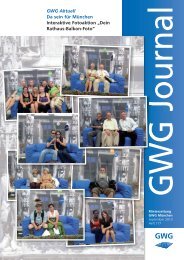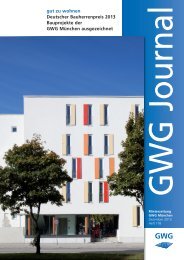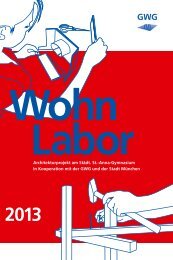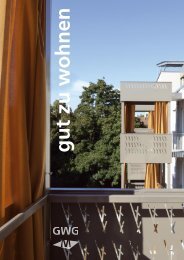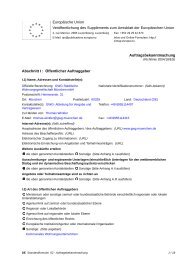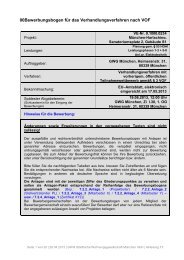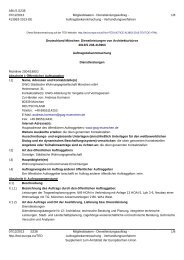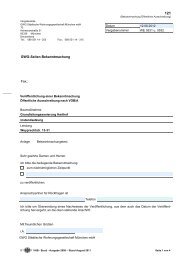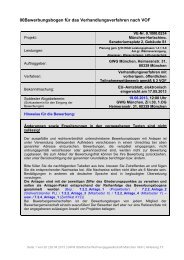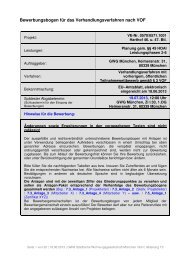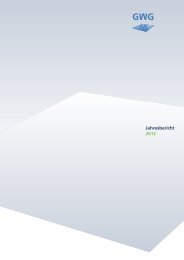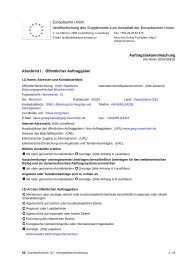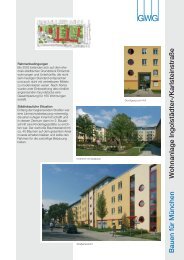New build - GWG München
New build - GWG München
New build - GWG München
You also want an ePaper? Increase the reach of your titles
YUMPU automatically turns print PDFs into web optimized ePapers that Google loves.
Horst W. Opaschowski's study "Germany 2030. How we will<br />
live in the future" (2008) demonstrates just how accurately<br />
this project is responding to the needs of society. The future<br />
researcher writes that people’s desire for community is unbroken<br />
despite the increase in individualisation: "Everybody under<br />
one roof - but everyone for themselves. A form of living that is<br />
as communicative as it is individual, which allows you to be by<br />
yourself and helps to prevent you from being abandoned."<br />
Even if Opaschowski is clearly focusing on shared housing for<br />
senior citizens, he still presents reference points that are of relevance<br />
to an extra-familial dialogue between the generations.<br />
And it goes yet further. It can be seen when comparing the<br />
last few years, for instance, that “people are getting ready for<br />
a new form of domesticity, feeling at home in familiar surroundings,”<br />
sums up Opaschowski and concludes, “more and<br />
more people are reflecting on the family and having their own<br />
four walls as a hive of stability.” Viewed against this background,<br />
the self-determined treatment of ageing, infirmity and<br />
community will take its place within the core of the future social<br />
order.<br />
Help as a service, community as an option, and freedom as a<br />
basic requirement, this is how one could sum up the basic<br />
principle of a communal residence for senior citizens – as a<br />
voluntary community that offers contacts and exchanges but<br />
remains rooted in the idea that people come together as and<br />
when they wish to. Such a community also tolerates retreat, if<br />
this is what some members wish.<br />
Each communal residence comprises individual apartments<br />
with a shower and small kitchen plus additional communal<br />
facilities, such as a large kitchen/living room, a lounge and an<br />
adjacent loggia. They also include a bath and washroom plus<br />
an additional room for guests or carers.<br />
Since it is oriented to the south and to the green courtyard,<br />
the living rooms enjoy plenty of light and sun. Residents have<br />
everything within their view and remain involved in the goings<br />
on in the community. Can’t the children sometimes be an<br />
annoyance when they run around and shout in the garden?<br />
“Not necessarily,” says the responsible <strong>GWG</strong> <strong>München</strong> project<br />
manager. “The people who move in here do so voluntarily,<br />
so anyone who lives here is here because they wants to be.”<br />
And it is this voluntary factor that creates the opportunities for<br />
a form of living that many have already experienced in their<br />
younger days.<br />
Living together in a small area, with the option to withdraw<br />
every now and then – this dual relationship of openness and<br />
retreat is already signalled by the long and wide south-facing<br />
balcony in front of all six apartments, which while connecting<br />
them into a structural whole, includes light partitions to maintain<br />
privacy between neighbouring units.<br />
64<br />
The renovation area:<br />
Sendling-Westpark<br />
9<br />
Garmischer Strasse<br />
9<br />
8<br />
Hinterbärenbadstrasse<br />
Krüner Strasse



